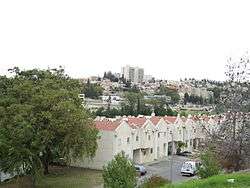Beit Shemesh
Beit Shemesh
| ||
|---|---|---|
| Hebrew transcription(s) | ||
| • ISO 259 | Beit Šemš | |
| • Also spelled | Bet Shemesh (official) | |
|
Modern Beit Shemesh | ||
| ||
 Beit Shemesh | ||
| Coordinates: 31°44′44.47″N 34°59′11.93″E / 31.7456861°N 34.9866472°ECoordinates: 31°44′44.47″N 34°59′11.93″E / 31.7456861°N 34.9866472°E | ||
| District | Jerusalem | |
| Founded | 1950 | |
| Government | ||
| • Type | City | |
| • Mayor | Moshe Abutbul | |
| Area | ||
| • Total | 34,259 dunams (34.259 km2 or 13.227 sq mi) | |
| Population (2015)[1] | ||
| • Total | 103,922 | |
| Name meaning | House of the sun | |


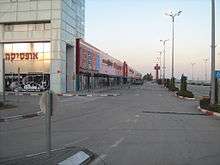

Beit Shemesh (Hebrew: בֵּית שֶׁמֶשׁ,; Arabic: بيت شيمش; Latin: Bethsames, Beth Shamesh or Bethshamesh and most often Beth-Shemesh in English translations of the Hebrew Bible) is a city located approximately 30 kilometres (19 mi) west of Jerusalem in Israel's Jerusalem District, with a population of 103,922 in 2015. The history of Beit Shemesh goes back to pre-biblical times. The modern city of Beit Shemesh was founded in 1950.
History
Canaanite and Israelite town
The ancient city of Beit Shemesh ("house of the sun" or "temple of the sun" in Hebrew) was originally named after the Canaanite sun-goddess Shemesh, who was worshipped there in antiquity. The ruins of the ancient biblical city can still be seen at Tel Beth-Shemesh (Tell er-Rumeileh), a tell located near the modern city.[2] In the Amarna letters Shamash is mentioned several times, along with Addu, as one of the greatest gods: the Pharaoh is "like Addu and Shamash".[3] The name Beth-Shemesh was shared by (at least) two other places in Palestine and one more in Egypt.[4]
Beit Shemesh is first mentioned in the Hebrew Bible in the Book of Joshua,[5] as a city in the territory of the tribe of Judah on the border between their territory and that of the tribe of Dan. In Joshua 21:16, this city was set aside as one of the 13 Kohanic cities for the priests of the tribe of Levi, the Kohanim. Another city by the same name, Beit Shemesh, is later mentioned in Joshua 19:38, being situated in the territory of the tribe of Naphtali.
The city located in the territorial bounds of the tribe of Judah is mentioned in the 6th chapter of 1 Samuel as being the first city encountered by the Ark of the Covenant on its way back from Philistia after having been captured by the Philistines in battle. In the book of 2 Kings, Beit Shemesh is again mentioned as being the site of the battle between Amaziah king of Judea and Jehoash king of Israel.
After the destruction of much of Judah by Sennacherib in 701 BCE, the city was abandoned for a while, but there seems to have been an attempt by a group of Judahites at resettling Beth Shemesh, judging by the refurbishing of the water reservoir in the 7th century BCE.[6] However, after the Babylonians conquest of Judah in the early 580s, either the new Babylonian rulers, or the nearby Philistine metropolis of Ekron favoured by them, apparently put and end to the initiative by sealing and covering over the vital water reservoir,[6] which was not uncovered until 2004. During the first Jewish return, at the beginning of the Second Temple period, there was no lasting revival of the city, as opposed to many other places in the vicinity such as Beit Guvrin, Maresha, and others. Consequently, the small Arab towns of Dayr Raban and Dayr Rafat used rocks for building from this very ancient source.
Byzantine period
A monastery and other remains from the Byzantine period have been found on the tell.[7]
Late Ottoman period
In the late 19th century, the site was used as a temporary harvest-time residence by local Arabs.[8][9] The small mosque of Abu Mizar stood there.[9]
1948 War
During the 1948 Arab–Israeli War, the Egyptian army invaded the area and set up a fortified post, called "Mishlat" in Hebrew, on a hill overlooking Beit Shemesh, within the Arab-village Dayr Aban. The post changed hands several times during fighting. The Harel Brigade occupied part of the post for several months giving rise to the name "the joint post" or the "Mishlat HaMeshutaf" with 60 meters dividing them and the enemy forces. The Mishlat was finally taken by the Harel force in the Ha-Har offensive during the night of 19–20 October 1948.
Beit Shemesh is the point from which the so-called Convoy of 35 set out to bring provisions to besieged Gush Etzion. On 15 January 1948 a group of 38 Palmach volunteers left Hartuv near Beit Shemesh. After one member of the group sprained his ankle, the group, now numbering 35, continued on its way. Their presence was discovered by two Arab women who encountered two scouts of the group near Surif. (An earlier version, that the soldiers were discovered by an Arab shepherd who they graciously let go, was based on a eulogy written by Ben-Gurion and is apparently apocryphal.)
State of Israel
On 6 December 1950, the Hartuv displaced persons camp "Ma'abarat Har-Tuv" was established on the site of the current-day Moshav Naham. The first inhabitants were Jewish Bulgarian immigrants. They were joined by more Jewish immigrants from Bulgaria, Iran, Iraq, Romania, Morocco and Kurdistan. In 1952 the first permanent houses were built in Beit Shemesh. Prior to 1948 the Ramat Beit Shemesh neighborhood area was the site belonging to the Arab village Bayt Nattif. This village was built on remnants of an ancient Judean town, with various remnants of Jewish settlement from the time, such as a mosaic floor, wineries and other remains, especially from the period of the Hasmonean kings and earlier. This area is currently under dispute about preservation, having been the subject of a grassroots campaign.
In its early years, Beit Shemesh came to typify the "Development Town" with a largely North African immigrant population. In 1977, following a writeup in Haaretz newspaper, Beit Shemesh was perceived as the main outpost for Menachem Begin's Likud party. He promised to rehabilitate neighborhoods and when Likud came to power that year, investment in the city increased.
The Israel Police maintains a bomb disposal specialist unit and training center in Beit Shemesh.[10]
Demographics
| Historical population | ||
|---|---|---|
| Year | Pop. | ±% |
| 1955 | 3,000 | — |
| 1961 | 7,000 | +133.3% |
| 1972 | 10,100 | +44.3% |
| 1983 | 13,000 | +28.7% |
| 1995 | 24,900 | +91.5% |
| 2008 | 72,700 | +192.0% |
| 2015 | 103,900 | +42.9% |
| Source: CBS | ||
When the city was built in the 1950s, it was initially settled by new immigrants from Iran, Iraq, Romania, Bulgaria, Morocco and Iraqi Kurdistan. In the 1990s, the city saw a large influx of new immigrants from the former Soviet Union, Ethiopia and English-speaking countries, turning it into a major center for Anglo immigrants. Considerable numbers have come from North America, the United Kingdom, South Africa and Australia. This population tends to be Orthodox, educated and from middle income groups. At the same time, Orthodox Jews from within Israel also began moving to the city, seeking roomier, low-cost housing.[11][12]
According to a city councillor, there were no Haredim in Beit Shemesh before the 1990s.[13] Since then, Beit Shemesh has become increasingly religious, with a large Haredi sector. Many synagogues and yeshivas have been built in the city. Religious communities represented in Beit Shemesh include Ger, Belz, Shomer Emunim, Satmar and Neturei Karta. In 2011 Haredim made up 40% of the population, of which an estimated 50 or 60 families with great influence are militant.[13] According to statistics published by the municipality, 63% of the city's schoolchildren in 2010 were Haredim.[14] 75% of the children entering the first grade in the 2012/2013 academic year will be registered in official Haredi institutions.[15]
The population of Beit Shemesh is expected to reach 150,000 in 2020.[14]
Urban development
Two new areas, the Nahala UMenucha neighborhood, and Ramat Beit Shemesh, were built in the 1990s, doubling the size of the city.
Ramat Beit Shemesh ("Beit Shemesh Heights") is an expansion that lies directly adjacent to, and to the south of, the original part of Beit Shemesh, colloquially referred to as "Old Beit Shemesh". It is located on a hill overlooking the old town. Ramat Beit Shemesh has a large, diverse Orthodox population. Originally, it consisted of two areas: Ramat Beit Shemesh Alef and Ramat Beit Shemesh Bet. In Ramat Beit Shemesh Bet, families belonging to Eda Haredit constitute the majority.[14] In 2002, following tensions between the Haredi and non-religious population, plans were drawn up to build another secular neighborhood, HaShachar. In 2007, Ramat Shilo, considered a subdistrict of Ramat Beit Shemesh, with both Dati Leumi and Haredi residents was built. In 2009, it was announced that a new neighborhood, Ramat Beit Shemesh Gimel, would be built as a largely Haredi neighborhood on a large block of state-owned land bordering southern Beit Shemesh.[14] In 2016 the Israeli Land Authority published tenders for 3,268 new apartments, to be built in the newly proposed areas of Ramat Beit Shemesh Dalet and Hey. According to plans, ultimately there are to be 8,300 new apartments in RBS Dalet alone.[16]
Beit Shemesh also has an urban kibbutz affiliated with the Kibbutz Movement, Tamuz, founded in 1987.
The large English-speaking community is concentrated in Ramat Beit Shemesh Alef, as well as in the Sheinfeld, Nofei Aviv, Migdal HaMayim and Givat Sharett neighborhoods of "Old Beit Shemesh".

Local government
The mayor of Beit Shemesh, Moshe Abutbul, is a member of Shas. The deputy-mayor, Shmuel Greenberg, is a member of United Torah Judaism (UTJ).[15] Haaretz quotes Abutbul as saying: "Beit Shemesh is not a Haredi city and will not be one."[14] In the 2009 elections, Shas and UTJ won nine seats in the 21-seat municipal council, one seat went to a new Haredi party called Tov.[14]
Formerly a Likud stronghold, in the 2006 Knesset elections United Torah Judaism became the city's strongest party, with 22.2 percent of the votes and Shas getting 19.9 percent. In 2009 Likud regained its primacy, obtaining 22.2 percent of the votes, and Shas also gained, garnering 20.9 percent, with United Torah Judaism a close third at 20.6 percent. Eda Haredit boycott the elections.[14]
2013 Municipal Elections
During the municipal elections held on 22 October 2013, acting on several anonymous tips, police raided several private residences and recovered 200 ID cards and disguising materials such as hats, glasses and wigs which law enforcement suspected were used or going to be used for fraudulent voting. Additionally, eight people were arrested on suspicion for engaging and coordinating fraudulent voting activities.[17]
On 10 December 2013 a three judge panel of the Jerusalem District Court nullified the results of the October municipal elections due to massive voter fraud and ordered a new election.[18]
Following an unprecedented 76% voter turnout rate, incumbent mayor Moshe Abutbul beat contender Eli Cohen with a 51% majority vote during the reelection which took place on 11 March 2014. [19]
Education
In 2001, there were 56 schools and 14,148 students in the city: 41 elementary schools with 10,716 elementary school students, and 20 high schools with 3,432 high school students. 40.3% of 12th grade students were entitled to a matriculation certificate.
Economy
Beit Shemesh has two industrial zones containing mainly small industry, particularly in the Northern industrial zone which is typified by carpentry and metalwork workshops, garages and wholesale and retail outlets. The Western industrial zone contains several larger companies including Beit Shemesh Engines Ltd. (BSEL) which manufactures and repairs jet engines and jet engine components, Barzellan and others. Nearby in the Noham industrial zone are situated various other factories and offices. Since the hi-tech boom of 1996–2001 Beit Shemesh has been host to several hi-tech startups including Omek Interactive.
Transportation
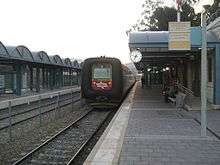
Beit Shemesh Railway Station provides hourly service on the Israel Railways Herzliya–Jerusalem line. The station is located in the north industrial zone of Beit Shemesh. It was reopened on 13 September 2003, having existed for over a century at the same location.[20] The station has three platforms.
Bus transportation within Beit Shemesh and most inter-city routes is operated by Superbus, which began service on 5 January 2009.[21] The Egged Bus Cooperative, which previously operated all bus service in and to Beit Shemesh, still operates a limited number of bus lines from Beit Shemesh to Jerusalem.
Sports
Beit Shemesh is home to numerous sports clubs all under the main sport associations (Beitar, Hapoel, and Maccabi). The city has soccer teams including juniors, seniors and over-35s teams and boasted a franchise in the Israel Baseball League. The Beit Shemesh Blue Sox represented Beit Shemesh in the league's only season, though they played their games at Gezer Field in Kibbutz Gezer due to a lack of proper facilities in Beit Shemesh. There is also a very active Little League in Beit Shemesh and Ramat Beit Shemesh, with over 300 members. In the field of judo, Elitzur Beit Shemesh has won many prizes. Israel Kung Fu and world Nunchaku champion (2001) Eli Ivgi was born in and lives in Beit Shemesh.
Arab-Israeli conflict
On 13 March 1997, seven 13 and 14-year-old girls from Beit Shemesh's AMIT Feurst School were killed at the "Island of Peace" site in Naharayim by a Jordanian soldier while they were visiting the joint Israeli and Jordanian tourist resort under Jordanian rule on a class trip.[22] King Hussein of Jordan went to Beit Shemesh a few days after the massacre to extend his condolences and ask forgiveness in the name of his country, a step which was seen as both courageous and touching.[23]
Gender issues and inter-communal tensions
In 2004 the Israel Association of Ethiopian Jews claimed that Ethiopian Jews working for the municipality were being paid below-minimum wages.[24] In 2011, the Association criticized the referral of Ethiopian Jews to three private pre-schools run by the mayor's wife.[25]
According to the Jerusalem Post, women who belong to a Haredi burqa sect in Beit Shemesh were ostracized by the Haredi community.[26] The leader of the movement, dubbed the "Taliban mother" by the Israeli press, was convicted by the Jerusalem District Court in 2009 on three counts of abuse of a minor and 25 counts of assault in aggravated circumstances, and sentenced to four years in prison. Her husband was also convicted of 10 counts of assault and three counts of abuse of a minor or helpless person, and was sentenced to six months in jail.[27][28]
In 2011, conflicts erupted in Beit Shemesh between extremist ultra-Orthodox men, possibly members of a group known as the Sikrikim,[29][30][31] and other residents of the town due to gender separation at local health clinics,[32] and so called ‘mehadrin buses’ where men sit in the front and women in the back.[33]
When the municipality removed a sign asking women to stay away from a synagogue, hundreds of Haredi men staged riots in which they attacked police officers and reporters.[34][35] Several placards urging segregation between men and women were put back after being removed by the police.[36]
After the opening of Orot Banot national-religious girls’ school in September 2011, groups of Haredi extremists gathered in front of the school, calling the girls names and spitting at them when they headed to and from school. Stones hurled at a boys' school belonging to the same educational network injured a boy in the leg. Two men were arrested on suspicion of throwing eggs and tomatoes at students.[37] In a demonstration outside the school a female journalist was assaulted by young Haredi men who cursed and spat at her, and a clash with parents of girls studying at the school was broken up by the police force.[37]
In December 2011, a public outcry was raised when a television news channel interviewed 8-year old Na'ama Margolese, who was cursed and spat at on her way to school by Haredi extremists.[38] The Jewish Daily Forward reported that the issue is really a property dispute over ownership of the school building.[39] Some Haredi women distributed flowers to the girls of Orot Banot school, telling them "sister to sister" that they were beautiful.[13] On 27 December 2011, a protest against extremism near the Orot Banot school drew 10,000 people.[40][41] After the incidents in Beit Shemesh were reported in foreign press, the US State Department updated its Jerusalem travel advisory advising visitors to "dress appropriately" when visiting ultra-Orthodox Jewish neighborhoods, or to avoid them entirely.[42]
Na'ama's mother Hadassah Margolese who has repeatedly spoken out on behalf of national religious Beit Shemesh residents against Haredi tendencies,[43] including about an occurrence in which little girls' faces were blurred out on Purim advertisements distributed in her neighborhood,[44] and a humiliating experience at the ritual bath reportedly left Beit Shemesh with her family in late July 2013 after being attacked by members of her own national religious community who accused her of exposing the community to public shame.[43]
in February 2015 Judge David Gideoni accepted a claim filed by four women who protested an illegal "modesty sign" posted in Ramat Beit Shemesh Bet. The judge ordered Mayor Moshe Abutbul and the Beit Shemesh Municipality to pay each of the women complainants NIS 15,000. The city then saw further signs of "religious radicalization" when the word "woman" was repeatedly erased from a sign at a women's health center.[45]
Archaeology

In 1971, excavations at Givat Sharett conducted by Israeli archaeologist Claire Epstein revealed a residential settlement of the Middle Bronze Age, including a temple.[46]
The most ancient iron workshop in the world was discovered in Beit Shemesh in 2003. The only remnants of a fortified city with an advanced water system, from the time of the early Kingdom of Judah was found here. The bones of animals found in the 12th–11th centuries BCE layer indicate a diet typical of the Israelites who inhabited the hill country in this period. These together with the pottery finds indicate the cultural influences on the inhabitants of this border town. However, it is not possible to determine their specific ethnic identity, which could be Canaanite, Philistine or Israelite.[2]
In August 2012 archaeologists from Tel Aviv University announced the discovery of a circular stone seal, approximately 15 millimetres in diameter. The seal was found on the floor of a house at Beit Shemesh and is dated to the 12th century BCE. According to Haaretz, "excavation directors Prof. Shlomo Bunimovitz and Dr. Zvi Lederman of Tel Aviv University say they do not suggest that the human figure on the seal is the biblical Samson. Rather, the geographical proximity to the area where Samson lived, and the time period of the seal, show that a story was being told at the time of a hero who fought a lion, and that the story eventually found its way into the biblical text and onto the seal."[47]
Animal bones found nearby may also be a clue to boundary disputes between different cultures. Pig bones have been found a few kilometres from Beit Shemesh, but only a few have been found actually at Beit Shemesh and at some point during the 11th century BCE it appears that the local population stopped eating pig. Haaretz reports that "According to Bunimovitz, when the pork-eating Philistines arrived in the country from the Aegean, the local people stopped eating pork to differentiate themselves from the newcomers."[47]
In 2014, archaeologists Irene Zilberbod and Tehila Libman announced the nearby discovery of a large compound from the Byzantine period that was most probably a monastery.[48] It comprised a residential area and an industrial area with wine and olive presses.[48] The remains of buildings with two or three stories and impressive mosaic floors were discovered.[48] The compound ceased to function in the early Muslim period and was subsequently occupied by other residents.[48]
Twinning and sister cities
Beit Shemesh is a Sister City of:
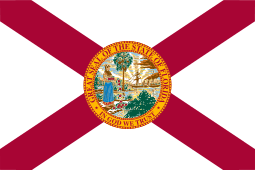
 Cocoa, FL, United States
Cocoa, FL, United States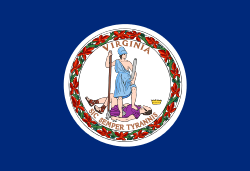
 Fairfax, VA, United States
Fairfax, VA, United States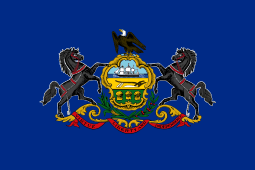
 Lancaster, PA, United States
Lancaster, PA, United States Nordhausen, Thuringia, Germany
Nordhausen, Thuringia, Germany Lhasa, Tibet Autonomous Region, China
Lhasa, Tibet Autonomous Region, China
 Ramapo, Rockland County, NY, United States
Ramapo, Rockland County, NY, United States Split, Croatia[49]
Split, Croatia[49]
In the Partnership 2gether program of the Jewish Agency for Israel, Beit Shemesh and the Mateh Yehuda Regional Council are linked to South Africa and Washington, D.C.[50]
After the Washington Post reported in October 2011 that Montgomery County, Maryland was considering a partnership with Beit Shemesh,[51] a local coalition, Human Rights Matter!, objected.[52] The campaign was supported by the Mossawa Center, an organization that defines its goal as the promotion of equality for the Arab minority in Israel but which has been criticized for its rejection of Israel as a Jewish state and its foreign funding from the European Commission, George Soros's Open Society Institute and the New Israel Fund, among others,[53] as well as Nobel Peace Prize laureate Mairead Maguire.[54]
References
- ↑ "List of localities, in Alphabetical order" (PDF). Israel Central Bureau of Statistics. Retrieved 16 October 2016.
- 1 2 Beit Shemesh – Biblical city on the border between Judah and Philistia, Israel Ministry of Foreign Affairs. Retrieved 23 November 2007.
- ↑ Israel. Routledge. 2005.
- ↑ BibleHub.com, Beth Shemesh, quoting Strong's Concordance etc.
- ↑ Joshua 15:10
- 1 2 Shlomo Bunimovitz and Zvi Lederman, Beth-Shemesh: A Biblical Border City between Judah and Philistia, Tel Aviv University, 2000 , retrieved 2016-09-01
- ↑ Claudine Dauphin (1998). La Palestine byzantine, Peuplement et Populations, Vol. III: Catalogue. BAR International Series 726. Oxford: Archeopress. p. 909.
- ↑ C. R. Conder & H. H. Kitchener (1883). The Survey of Western Palestine. III. London: The Committee of the Palestine Exploration Fund. p. 60.
- 1 2 M. V. Guérin (1869). Description géographique, historique et archéologique de la Palestine. Judée II. Paris. pp. 18–22.
- ↑ Omri Efraim. Israel Police get 1st female sapper, Israel News, 20 September 2011.
- ↑ http://www.timesofisrael.com/the-growing-pains-of-beit-shemesh/
- ↑ Nathan Jeffay (15 January 2009). "Building a Bit of America in Beit Shemesh". The Jewish Daily Forward. Retrieved 30 December 2011.
- 1 2 3 Sherwood, Harriet (31 October 2011). "The battle of Bet Shemesh". The Guardian. Retrieved 18 December 2011.
- 1 2 3 4 5 6 7 Ettinger, Yair (8 September 2010). "Black and white in color". Haaretz. Retrieved 21 February 2012.
- 1 2 Ettinger, Yair (8 February 2012). "Three quarters of Beit Shemesh first-graders will attend ultra-Orthodox schools next year". Haaretz. Retrieved 21 February 2012.
- ↑ "Tender Publicized for 3,268 Housing Units in Beit Shemesh - See more at: http://www.theyeshivaworld.com/news/headlines-breaking-stories/374066/tender-publicized-for-3268-housing-units-in-beit-shemesh.html#sthash.FENWstTB.dpuf". External link in
|title=(help) - ↑ 200 IDs seized in Beit Shemesh in suspected voter fraud | JPost | Israel News
- ↑ Court orders new elections in Beit Shemesh | JPost | Israel News
- ↑ Sharon, Jeremy. "Moshe Abutbul narrowly defeats Eli Cohen in repeat of Beit Shemesh mayoral election | JPost | Israel News". JPost. Retrieved 2014-03-14.
- ↑ Friedman, Jane. "SLOW TRAIN TO JERUSALEM", The New York Times, 7 August 1983. Retrieved 23 September 2007. "Built in 1892 by the French during the Turkish reign, the Tel Aviv-Jerusalem line is one of the few early Middle East train lines to have survived the effects of wars and sands."
- ↑ סופרבוס (Superbus) (Hebrew)
- ↑ Serge Schmemann (13 March 1997). "Jordanian Soldier Kills 7 Israeli Schoolgirls". The New York Times. Retrieved 29 December 2011.
- ↑ "With condolence visit to Israel, King Hussein spurs talks", CNN, 16 March 1997. Retrieved 22 July 2007. "King Hussein of Jordan knelt in mourning Sunday with the families of seven Israeli schoolgirls gunned down last week by a Jordanian soldier, saying they were all 'members of one family.'"
- ↑ "Beit shemesh program pays Ethiopian immigrants less than minimum wage". Haaretz. 27 December 2004. Retrieved 18 December 2011.
- ↑ "NGO report demands end to segregation of Ethiopian students". The Jerusalem Post. 13 December 2011. Retrieved 18 December 2011.
- ↑ Matthew Wagner (27 March 2008). "Beit Shemesh 'Burka' cult unveiled". Jerusalem Post. Retrieved 16 January 2012.
- ↑ Rotem, Tamar (1 June 2009). "The Trial of "Mother Taliban"". Haaretz (in Hebrew).
- ↑ http://www.haaretz.com/news/abusive-haredi-taliban-mother-gets-four-years-in-prison-1.4859
- ↑ "They will come for you too". Cross Currents. 30 December 2011. Retrieved 1 January 2012.
- ↑ "American enclave stands up to extremists". The Jewish Daily Forward. 29 December 2011. Retrieved 1 January 2012.
- ↑ "Beit Shemesh becomes focus point over growing outrage over violent religious extremism". The Jewish Press. 28 December 2011. Retrieved 1 January 2012.
8-year-old Na’ama Margolis, the daughter of Orthodox American immigrants, was spat on by a member of the Sikrikim
- ↑ Ettinger, Yair (30 December 2011). "Ultra-Orthodox extremism is a reaction to growing reform in the community". Haaretz. Retrieved 21 February 2012.
- ↑ "Yael Navon of Betar Illit Takes On Bus Gender Separation". Yeshiva World News. 31 October 2011. Retrieved 18 December 2011.
- ↑ Rosenberg, Oz; Ravid, Barak; Nesher, Talila (27 December 2011). "Thousands of Israelis protest gender segregation in Beit Shemesh". Haaretz. Retrieved 20 January 2015.
- ↑ Greiner, Lena; Yaron, Gil (30 December 2011). "The Ultra-Orthodox in Israel. A Clash of Cultures in the Holy Land". Der Spiegel. Retrieved 8 August 2013.
- ↑ Kahana, Menahem (26 December 2011). "Jewish gender segregation protest in Israel turns violent". National Post. Retrieved 20 February 2012.
- 1 2 Nashoni, Kobi (21 September 2011). "Girls' school 'backed by evil regime'". ynet news. Retrieved 18 December 2011.
- ↑ "Israeli girl's plight highlights extremists". Associated Press. Retrieved 29 December 2011.
- ↑ Kaplan Sommer, Allison (29 December 2011). "Letter From Beit Shemesh: American Enclave Stands Up to Extremists". The Jewish Daily Forward. Retrieved 30 December 2011.
- ↑ Oz Rosenberg; Nir Hasson; Revital Blumenfeld; Barak Ravid; Talila Nesher (28 December 2011). "Beit Shemesh rally attracts thousands to protest extremism". Haaretz. Retrieved 29 December 2011.
- ↑ Sharon, Jeremy (28 December 2011). "Beit Shemesh rally 'a success' say protest leaders". The Jerusalem Post. Retrieved 1 January 2012.
- ↑ Chabin, Michele (6 February 2012). "U.S. tourists to Israel advised to dress modestly". The Washington Post. Retrieved 20 February 2012.
- 1 2 Kaplan Sommer, Allison (26 July 2013). "Symbol of struggle against Haredi coercion bids farewell to Beit Shemesh". Haaretz. Retrieved 5 August 2013.
- ↑ Kaplan Sommer, Allison (31 January 2012). "In Beit Shemesh, Even Purim Is Politicized". The Jewish Daily Forward. Retrieved 5 August 2013.
- ↑ Word 'woman' erased from HMO sign YNET, 9 Mar 2015
- ↑ "Claire Epstein, Jewish Women Archive". Jwa.org. Retrieved 2013-08-08.
- 1 2 Hasson, Nir (30 Jul 2012). "National Seal found by Israeli archeologists may give substance to Samson legend". Haaretz. Retrieved 3 September 2013.
- 1 2 3 4 Nir Hasson (20 September 2014). "Archaeologists discover impressive Byzantine-era compound near Beit Shemesh". Haaretz.
- ↑ "Gradovi prijatelji Splita" [Split Twin Towns]. Grad Split [Split Official City Website] (in Croatian). Archived from the original on 2012-03-24. Retrieved 2013-12-19.
- ↑ "Jewish Agency for Israel: Beit Shemesh – Mateh Yehuda – Washington – South Africa". Retrieved 18 December 2011.
- ↑ Lazo, Luz (11 October 2011). "Montgomery sister city agreement strengthens ties to Salvadoran city". The Washington Post. Retrieved 29 December 2011.
- ↑ "Website Human Rights Matter!". Mdhumanrightsmatter.org. Archived from the original on 26 April 2012. Retrieved 2013-08-08.
- ↑ "Mossawa". NGO Monitor. 21 August 2014. Retrieved 20 January 2015.
- ↑ "Website Human Rights Matter! Endorsers". Mdhumanrightsmatter.org. Archived from the original on 26 April 2012. Retrieved 2013-08-08.
External links
| Wikimedia Commons has media related to Beit Shemesh. |
- Beit Shemesh Municipality
- Places To Visit in Beit Shemesh
- Shemesh OnLine
- ShemeshDirectory
- Ramat Beit Shemesh
- "Bet Shemesh Corner" News
- Lilia Kirshenbaum, Tsagai Asamain and Avi Perets, Bet Shemesh- Machsia, Khirbet el-Suyyagh: Relocation of an olive oil press, Israel Antiquities Authority Site - Conservation Department
